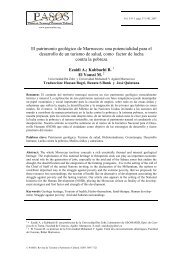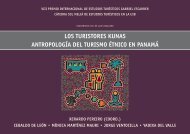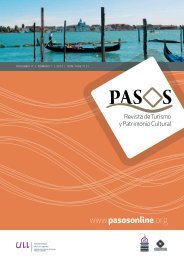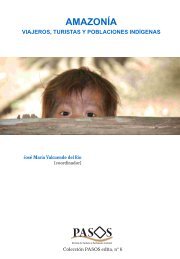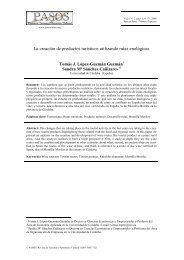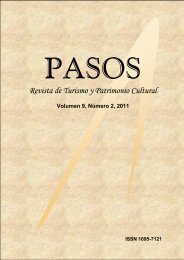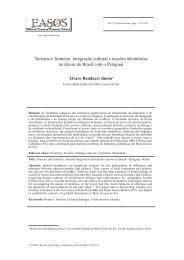Post Hoc Tourist Segmentation with Conjoint and Cluster ... - Pasos
Post Hoc Tourist Segmentation with Conjoint and Cluster ... - Pasos
Post Hoc Tourist Segmentation with Conjoint and Cluster ... - Pasos
Create successful ePaper yourself
Turn your PDF publications into a flip-book with our unique Google optimized e-Paper software.
Sérgio Dominique Ferreira Lopes, Antonio Rial Boubeta <strong>and</strong> Jesús Varela Mallou 493<br />
maximize the profitability.<br />
In this context, Portugal must fallow the<br />
marketing strategies of Spain <strong>and</strong> France<br />
(international leaders in terms of tourism<br />
revenues). Such countries have one common<br />
factor: they guide themselves by a<br />
strong marketing approach in the management<br />
of their tourism resources. And<br />
the recent history confirms that those countries<br />
(France <strong>and</strong> Spain) are the most competitive<br />
in the world. This phenomenon can<br />
be explained by several factors, such as: a)<br />
a huge professionalization of all sectors<br />
related <strong>with</strong> tourism; b) the marketing <strong>and</strong><br />
the sales of this sector (travel agents) are<br />
carefully structured; c) the strategy of<br />
management is very well coordinated because:<br />
i) the promotion is very weighted; ii)<br />
the offer is adjusted to the consumers’<br />
needs <strong>and</strong> preferences; iii) <strong>and</strong> a structured<br />
strategy for the consumers’ loyalty through<br />
marketing campaigns (e.g.: in strategic<br />
locations - fairs).<br />
Based on the assumption that all processes<br />
that are part of Tourism Marketing<br />
(described above) have in their essence to<br />
meet the needs <strong>and</strong> the preferences of tourists,<br />
it’s essential to know which the structures<br />
of the tourist preferences are. This<br />
allows segmenting market into clusters<br />
that share homogenous preferences.<br />
Santesmases (1999, p.214) states that<br />
segmenting markets is the "process of dividing<br />
the market into homogeneous<br />
groups in order to carry out a marketing<br />
strategy to each one, allowing to satisfy<br />
more effectively their needs <strong>and</strong> to achieve<br />
the commercial objectives of the company. "<br />
According to the same author (Santesmases,<br />
1999), segmenting markets presents<br />
several advantages, such as finding markets<br />
that are not saturated, i.e., where<br />
there are still business opportunities; it<br />
allows to set priorities; it facilitates the<br />
analysis of competition, providing information<br />
about who are the direct competitors<br />
<strong>and</strong> allows companies to offer products/services<br />
that best suit specific needs of<br />
each segment.<br />
Nowadays, market researchers analyse<br />
products <strong>and</strong> services as a set of characteristics<br />
or attributes <strong>and</strong> these products tend<br />
to be configured according to the consumers’<br />
needs <strong>and</strong> preferences. So, it’s important<br />
to know which the assessment of those<br />
attributes is <strong>and</strong> to know in which way<br />
each attribute <strong>and</strong> level of attribute contribute<br />
to elect a certain product. Therefore,<br />
<strong>Conjoint</strong> Analysis is very useful to<br />
analyze the consumers’ preferences (Wittink<br />
& Cattin, 1989; Wittink, Vriens &<br />
Burhenne, 1994).<br />
As it’s currently known, it’s not possible<br />
to please everyone’s needs, so it’s inevitable<br />
segmenting markets. Hence, business organizations<br />
need to group consumers into<br />
segments, to satisfy their needs <strong>and</strong> to increase<br />
their level of satisfaction. Therefore,<br />
the better is the segmentation the better<br />
will be the adjustment of the products to<br />
the consumers’ preferences.<br />
Until today, there are just a few empirical<br />
researches in tourism <strong>with</strong> real methodological<br />
basis. Spain, <strong>and</strong> more specifically<br />
Galicia, has been consolidating in<br />
recent years a strong marketing approach<br />
for the management of tourism resources,<br />
being a good example to follow by other<br />
countries.<br />
In this context, <strong>Conjoint</strong> Analysis is a<br />
methodology that has its origins in the Psychology<br />
<strong>and</strong> in Marketing. The works of<br />
Luce <strong>and</strong> Tukey (1964) are the first references<br />
<strong>and</strong>, later, Wilkie & Pessemier (1973)<br />
started to talk about multi-attribute models,<br />
as a way to analyze <strong>and</strong> underst<strong>and</strong> the<br />
preferences of the consumers (Varela &<br />
Braña, 1996; Picón & Varela, 2000; Braña,<br />
Rial & Varela, 2001; Picón, Braña &<br />
Varela, 2002; Picón, Varela & Braña, 2006;<br />
Ramírez, 2008).<br />
Like this, the multi-attribute models explain<br />
the way that consumers former their<br />
preferences (for products or services). So,<br />
preferences are created by the consumers’<br />
perception <strong>and</strong> the main goal of the <strong>Conjoint</strong><br />
Analysis is to estimate the value of<br />
each characteristic or levels of attribute<br />
that defines a product. With these values,<br />
it’s possible to know which the characteristics<br />
of the consumers’ behaviours are. And<br />
the compensatory models (Fishbein &<br />
Ajzen, 1975) are linked to the multiattribute<br />
models <strong>and</strong> the various levels of<br />
attributes can compensate each other. It’s<br />
PASOS. Revista de Turismo y Patrimonio Cultural, 7(3). 2009 ISSN 1695-7121



